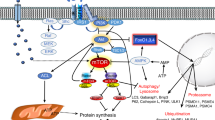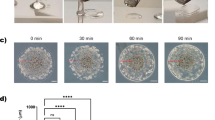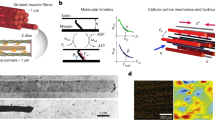Abstract
TENDONS immersed in a solution of mercury – potassium iodide contract; if held at constant length they exert tension, there being a reversible relation between tension and concentration of the reagent1. This system has been proposed as a model of the molecular mechanism of muscular contraction2, and may be taken as typical of such models3. The reagent appears to act as a ‘plasticizer’, weakening attractions between protein molecules, and leaving them free to curl up under the influence of thermal agitation.
This is a preview of subscription content, access via your institution
Access options
Subscribe to this journal
Receive 51 print issues and online access
$199.00 per year
only $3.90 per issue
Buy this article
- Purchase on SpringerLink
- Instant access to full article PDF
Prices may be subject to local taxes which are calculated during checkout
Similar content being viewed by others
References
Pryor, M. G. M., Proc. Roy. Soc., B, 137, 71 (1950).
Pryor, M. G. M., “Progress in Biophysics”, 1 (edit. Randall and Butler, London: Butterworth, 1950).
Pryor, M. G. M., “Deformation and Flow in Biological Systems” (edit. Frey Wyssling. Amsterdam: North Holland Pub. Co., 1952).
Wiegand, W. B., Trans. Inst. Rubber Indust., 1, 141 (1925).
Wöhlisch, E., and du Mesnil de Rochement, R., Z. Biol., 85, 406 (1927).
Weber, H. H., Z. Elektrochem., 55, 511 (1951).
Mommaerts, W. F. H. M., Biochim. Biophys. Acta, 4, 50 (1950).
Author information
Authors and Affiliations
Rights and permissions
About this article
Cite this article
PRYOR, M. Heat Exchanges of a Muscle Model. Nature 171, 213 (1953). https://doi.org/10.1038/171213a0
Issue date:
DOI: https://doi.org/10.1038/171213a0
This article is cited by
-
The mechanochemistry of force production in muscle
Journal of Muscle Research and Cell Motility (1981)
-
Mechanochemical Engines
Nature (1966)



